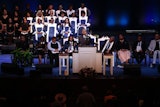18 More Graves Found on U.Va.’s Expansion Site
CHARLOTTESVILLE, Va.
Archaeologists exploring a site at the University of Virginia have found 18 more grave shafts that could be part of a community burial ground for free Black people, university officials said Thursday.
The discovery of the additional graves along Venable Lane near Cabell Hall bring the total number of graves to 32; graves of four adults and eight children were found when archaeologists discovered the cemetery in 1993 and two more graves were found in May.
The explorations are part of preparations for the university’s South Lawn Project, which will add several classroom buildings and include a park-like area to memorialize the site. Archaeologists don’t plan to dig deeper and exhume the graves or coffins, officials said.
Before the most recent 18 graves were found, archaeologists theorized that the cemetery held the remains of Catherine “Kitty” Foster, a free Black woman who purchased the land in 1833, and her descendants. Some family members were thought to have worked as seamstresses and laundresses before they sold the land in 1906.
But the newly discovered graves aren’t all next to the original 12 discovered in 1993 during a parking-lot expansion. Seven have been discovered about 15 feet away from the main burial group, indicating that the cemetery might have been used by more than the Foster family, according to Steve Thompson, a principal investigator with Rivanna Archaeological Services, which U.Va. hired to examine the site.
The second cluster also could represent an extended branch of the Foster family, or could include members of a 19th-century Black community dubbed “Canada” that developed east and west of Foster’s property after the Civil War, university officials said.
In 1906, as the Canada neighborhood was losing its identity as a Black enclave, the Foster family property was sold to White developers. The graves were eventually forgotten, covered over by development and the passage of time, until their rediscovery in 1993.
Corey D.B. Walker, an assistant professor of religious studies and a member of the South Lawn Project’s archaeological committee, said he thinks the cemetery is more than a Foster family plot, as other cemeteries have turned up similar “cluster” burials.
“We see that pattern in other late-19th century cemeteries,” said Walker, who has studied African-American burial practices. “They can’t all be from one household. We have to think along the lines of a community burial ground — a Canada cemetery.”
— Associated Press
© Copyright 2005 by DiverseEducation.com


















